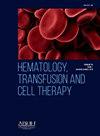IS ALL-TRANS RETINOIC ACID EFFECTIVE IN PULMONARY HAEMORRHAGE IN PATIENTS WITH ACUTE PROMYELOBLASTIC LEUKAEMIA?
IF 1.8
Q3 HEMATOLOGY
引用次数: 0
Abstract
Objective
Acute myeloid leukaemia (AML) develops from myeloid precursor cells in the bone marrow. Acute promyelocytic leukaemia (APL) is an aggressive subtype (5-10%) of AML with the t(15;17) translocation. It is sensitive to all-trans retinoic acid (ATRA). The aim of this article is to emphasise the efficacy of ATRA treatment in pulmonary haemorrhage associated with APL and to contribute to the literature.
Case Report
A 14-year-old girl presented with malaise, pallor and bruises since 1 month. On examination, she was pale and had bruises on the trunk and extremities, but no organomegaly.
Investigations revealed pancytopenia and atypical mononuclear cells in peripheral blood smear. Bone marrow aspirate showed promyeloblasts (80%) and AML-M3 surface markers were positive in flow cytometry. Cytogenetic analysis revealed t(15;17) translocation.
AML-BFM 2012 chemotherapy protocol was initiated. During induction chemotherapy, the patient developed dyspnoea and pulmonary haemorrhage. The child was transferred to intensive care unit and ATRA was added to the chemotherapy at a dose of 25 mg/m2/day. Coagulation tests improved 2 days after ATRA treatment and clinical findings improved 4 days later. On the 9th day of intensive care unit admission, the patient was transferred to inpatient ward and there was no bleeding during follow-up.
Discussion
Haemorrhagic complications are frequent in APL patients and are one of the main causes of early death (5-9%) (1,2).
Increased plasmin production (60-fold) due to excessive annexin-II receptor expression in promyeloblasts has been shown to cause fibrinolysis. It is thought that patients develop increased hyperfibrinolysis rather than consumption coagulopathy (2). ATRA is highly effective in bleeding control (3).
Conclusion
Patients should be monitored with coagulation tests at regular intervals due to the high risk of bleeding. Undesirable haemorrhagic conditions may develop before and during treatment. ATRA can provide effective control in treatment.
求助全文
约1分钟内获得全文
求助全文
来源期刊

Hematology, Transfusion and Cell Therapy
Multiple-
CiteScore
2.40
自引率
4.80%
发文量
1419
审稿时长
30 weeks
 求助内容:
求助内容: 应助结果提醒方式:
应助结果提醒方式:


